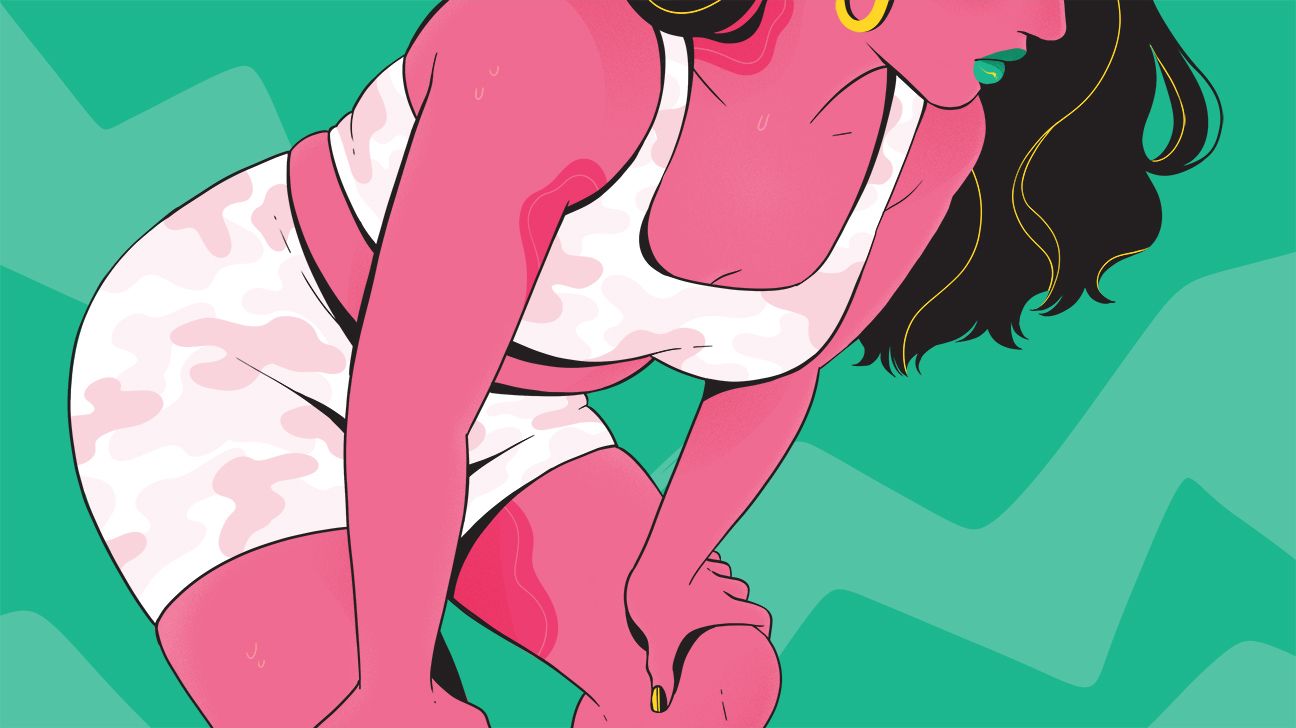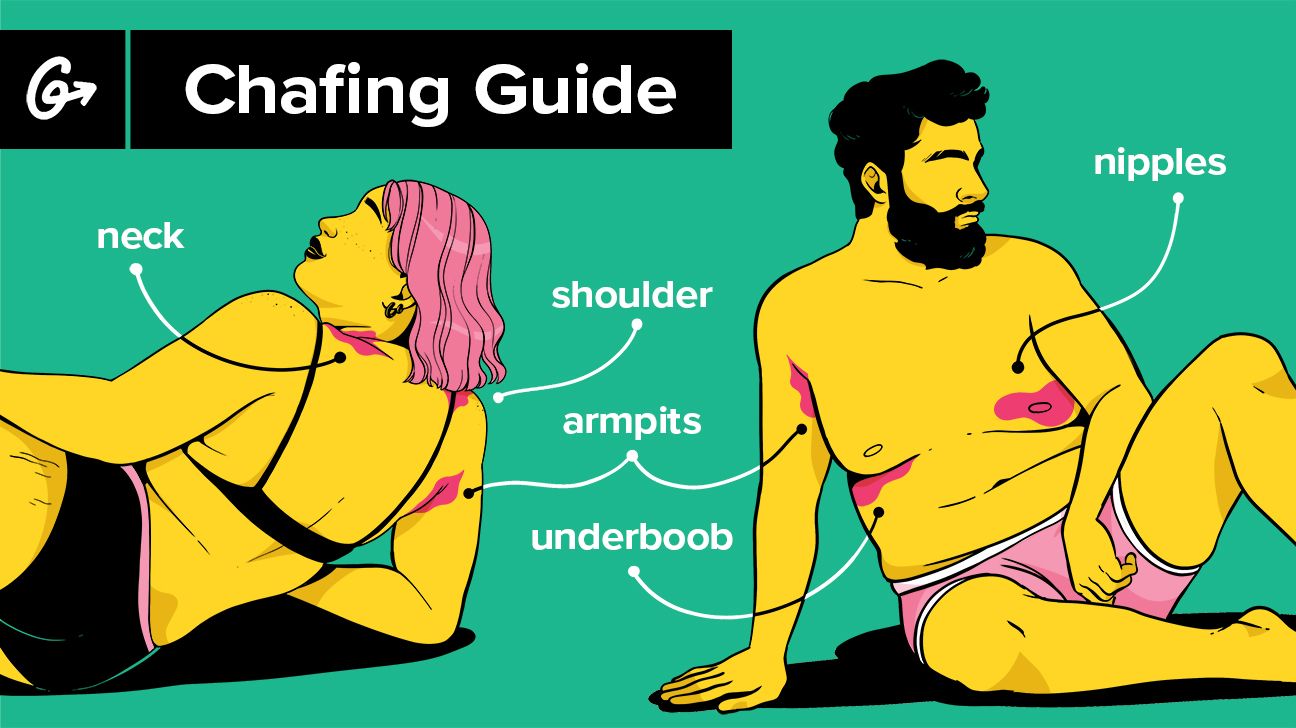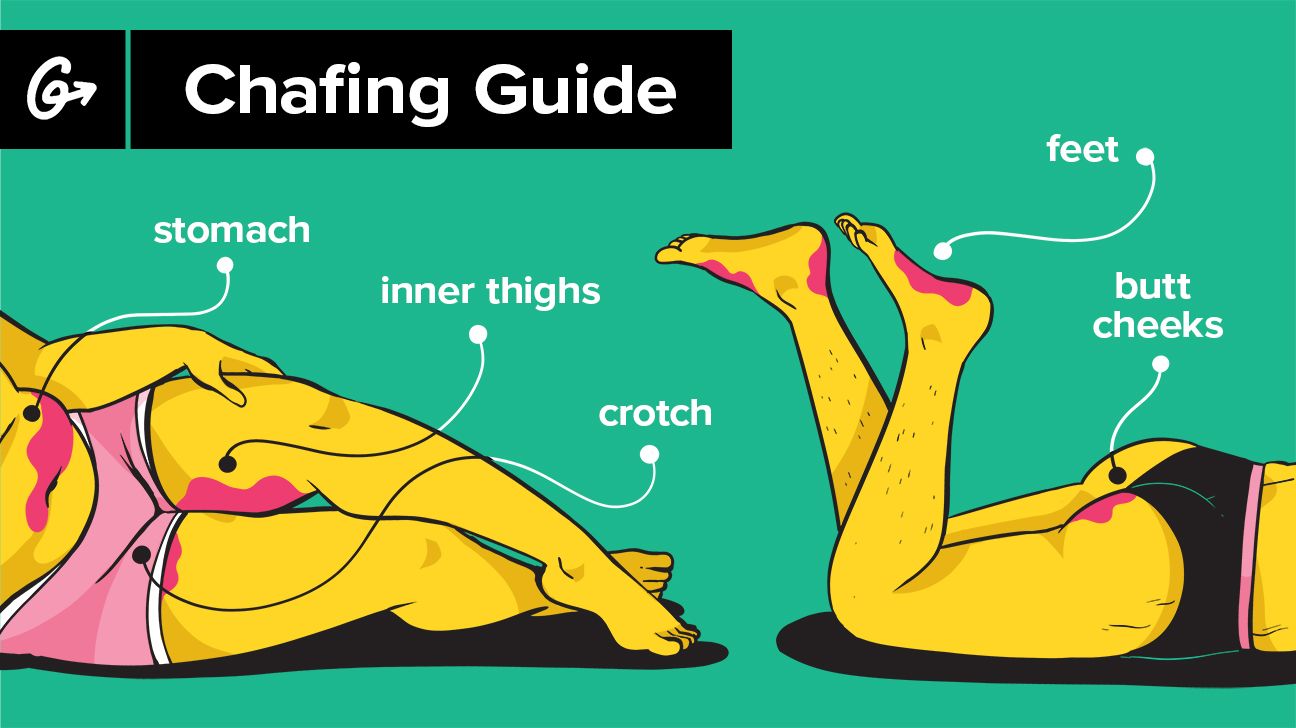We include products we think are useful for our readers. If you buy through links on this page, we may earn a small commission. Here’s our process.
Greatist only shows you brands and products that we stand behind.
Our team thoroughly researches and evaluates the recommendations we make on our site. To establish that the product manufacturers addressed safety and efficacy standards, we:- Evaluate ingredients and composition: Do they have the potential to cause harm?
- Fact-check all health claims: Do they align with the current body of scientific evidence?
- Assess the brand: Does it operate with integrity and adhere to industry best practices?
Fabric rubbing you in all the wrong places? Thighs trying to light a fire? Butt and bike seat getting up close and personal? Chafing doesn’t discriminate — that red, painful, and sometimes bumpy or blistered rash can happen to anyone.
Friction is the real enemy here (so say buh-bye to talk of thunder thighs and “chub rub”). You may be prone to chafing if you run, bike, or do any other friction-creating activity. Add heat and sweat, and you have the perfect recipe for chafing.
Because chafing isn’t picky, it can happen in quite a few places on your body:

Neck
This is a common chafing area for people who swim, because bathing suit straps can rub on your neck. High-necked clothing can also cause neck chafing. And if you live in a larger body, chafing can happen in folds of skin on your neck and chin.
Shoulders
Friction from bra straps, sports bras, backpack straps, and even just ill-fitting shirts can cause chafing on your shoulders.
Armpits
Armpit chafing can happen if you wear the wrong size shirt or bra, if you shave your pits, or if you just have sensitive skin. The arm skin between your armpits and your side is also prone to chafing from skin or clothing.
Underboob
If your girls (or boys) are hanging low, sweat and friction can cause chafing. Bras can also cause underboob chafing, especially if they’re too tight or too loose.
Nipples
Nipple chafing is common for men who run with shirts on. Sports bras usually prevent nipple chafing in women, but ill-fitting and poorly designed bras can cause chafing elsewhere (hello, underboob and armpits).
Breastfeeding is the demon of nipple chafing, especially for first-timers, and can do major damage in the form of cracked and bleeding nips. (Good thing babies are so dang cute!)
Stomach
Skin-to-skin friction and trapped moisture can cause stomach chafing in some people. If your waistband is too tight or loose, it can also rub on your skin and create a rash.
Butt cheeks
Friction from your butt cheeks rubbing together or from fabric (especially the wrong workout clothes) can cause a nice rash right in your crack. Activities like hiking, running, and cycling are the usual culprits. And heat and sweat usually make chafing worse.
Groin, penis, and vulva
Groin, penis, and testicle chafing are common (since a lot of swinging goes on down below). People with vulvas can also experience chafing down there, especially as a result of wearing pads or shaving.
Inner thighs
The inner thighs are one of the most common areas for chafing — it can and does happen to anyone.
Feet
Feet sweat… a lot. If your toes are squished in shoes all day, you’re running a lot, or you’re wearing less-than-ideal socks, rashes and blisters may be right around the corner.
Use the power of powder
How it works
Baby powder, cornstarch, and other anti-chafing powders wick away moisture and create a barrier between skin and fabric (or skin and skin) to reduce friction.
Some powders can end up clumping (aggravating chafing even more), so try different products to see what works best for you.
What it’s best for
You can use powder just about anywhere on your body, and there are male- and female-specific powders ideal for your downstairs equipment. It can be a little messy, so use it with care to avoid looking like you wrestled a powdered doughnut.
Our picks
- For dudes: Chassis Premium Powder for Men Cooling Max. Featuring an intense cooling action, it fights sweat, odor, and chafing all day long.
- The OG: Anti Monkey Butt. This OG chafing powder features cooling calamine.
- For chicks: Lady Anti Monkey Butt. Like the original, this product contains cornstarch for a silky-smooth feel. Plus, it’s safe to use on all lady parts.
- Fan fave: Lush Silky Underwear Dusting Powder. Smell sexy AF and be chafe-free with jasmine-and-vetiver-scented cornstarch and kaolin clay. This powder absorbs moisture to keep you smooth while tiny shavings of cocoa butter nourish your skin.
How to DIY
Make your own powder by using cornstarch and/or arrowroot as a base. Then fancy it up a bit with powdered calendula and lavender essential oil to help soothe sore skin.
What to avoid
Talcum powder (the original baby powder) used to be the go-to powder for chafing and diaper rash, but it’s been shrouded in controversy for years. A 2018 review of studies found a slight link between the use of talcum powder and ovarian cancer. Talc is also banned in Europe for use in health and beauty products.
The evidence against it may be weak, but with so many safer alternatives, it’s a good idea to skip the talc!
Lube up
How it works
Ointments, creams, oils, and other lubricating products can help reduce hot spots by creating a barrier against moisture and friction. Natural oils and moisturizers, like coconut oil and shea butter, can also make great chafing lubricants and are inexpensive.
Many products also contain anti-inflammatory or cooling agents (like aloe vera) to help soothe red, raw skin.
What it’s best for
Lubricating products are made for all areas. If your lubrication of choice is oily, be careful using it anywhere that could stain your clothes.
To avoid grease stains, you can also cover the chafed area with a bandage after applying a lubricant or wait until you get home, strip down to your skivvies, and lube it up!
Our picks
- Multi-purpose: Coconut oil. Is there anything coconut oil can’t do? Full of polyphenols and fatty acid components, coconut oil creates a protective, antibacterial, and anti-inflammatory barrier.
- All-natural: Shea butter. Richer in texture than coconut oil, shea butter has antioxidant and anti-inflammatory properties. A little goes a long way!
- The OG: Chamois Butt’r. This classic chafing cream is both long lasting and non-staining.
- For thighs: Body Glide. Regularly used by runners, this product is applied like a stick of deodorant. Body Glide isn’t oily and blends into your skin. It can stand up to sweat, humidity, and water.
- For feet: ChafeX Anti Chafe Anti Blister Skin Cream. This cream is designed for feet and blistering. It actually bonds to your skin rather than just coating it (fancy!), and it’s waterproof.
- For nether regions: DZNuts Chamois Cream. Designed to help cyclists protect the entire hiney, this chafing cream comes in men’s and women’s versions to protect your bits.
How to DIY
Add aloe vera gel to your coconut oil or shea butter (or even use it on its own) to speed healing and cool hot spots.
What to avoid
Your grandma might disagree, but there’s really no reason to use a petroleum-based product on your skin (Vaseline, mineral oil, etc.). Research suggests these products may contain toxic hydrocarbons that are linked to cancer.
Lube hack:
Feeling the burn, but don’t have anti-chafing products handy? You can use your regular stick deodorant as a friction barrier!
Wear moisture-wicking fabrics
How it works
Natural fabrics are not your friend when it comes to chafing. Instead, look for snug (but not too tight) clothes that have minimal seams and tags and are made from synthetic, moisture-wicking materials. (This is your excuse to exclusively wear leggings!)
What it’s best for
You can find anti-chafing clothing designed for the entire body, especially your thighs, groin, feet, shoulders, and underboobs.
Our picks
- Socks: Balega Blister Resist Quarter Running Socks. Turn your sweaty feet into happy feet! If your shoes are rubbing you raw or you’re a runner/cyclist, these help keep your feet dry.
- Sports bra: Zensah Seamless Sports Bra. Help prevent underboob, underarm, or shoulder strap chafing by investing in a seamless, moisture-wicking sports bra.
- Shapewear: Thigh Society Anti-Chafing Slip Shorts. Ladies, if you really want to stop the rub, get a pair of compression shorts (aka shapewear). They’ll stop friction when you’re wearing a skirt.
- Biker shorts for chicks: Athleta Salutation Stash Pocket II 7″ Short. An easy solution for inner thigh chafing is to wear a pair of snug shorts, like these biker shorts that are already on-trend.
- Compression shorts for dudes: Under Armor Compression Shorts. If you’re not afraid to show off your equipment, compression shorts can help with groin and inner thigh chafing. If you prefer to hide the family jewels, you can wear compression shorts under looser gym shorts or pants.
What to avoid
When it comes to chafing, natural fabrics usually lead to the F-word (friction, people!). You’ll especially want to steer clear of cotton because it tends to absorb moisture, bunch up, and become heavy.
Shirts vs. skins
Guys can consider exercising shirtless to prevent nipple chafing. (This would be ideal for everyone if we could free the nipple.) No shirt = no nipple chafing.
Cover it up: Bandages and specialty covers
How it works
If changing up your clothing isn’t getting the job done, bandages or specialty covers, like nipple guards or thigh bands, are another option to kill the rub.
What it’s best for
Protect your nips with bandages and special anti-chafe coverings ideal for smaller areas. Some products are also made for thigh chafing.
Our picks
- The OG: Band-Aid. Bandages are most often used on nipples to prevent chafing or to keep it from getting worse. If you’re applying a greasy ointment, you can also use bandages to cover the area to prevent staining your clothes.
- Nipple covers: NipEaze. These unisex nipple covers, popular with serious athletes, stop nipples from chafing against fabric.
- Nursing pads: Bamboobies Washable Nursing Pads. Nursing moms can use these to buffer friction on sore nipples while also soaking up milky leaks.
- Anti-chafe bands: Bandelettes Thigh Bands. These slip-on, adjustable bands of fabric come in several lacy designs and colors and help prevent inner thigh chafing. There are also plain bands to match a variety of skin tones.
- Clean the area with a mild soap and lukewarm water.
- Pat (don’t rub) the area dry. Make sure it gets completely dry. If you have some extra time, let it air out. You can even stand in front of a fan or use your blow-dryer’s cool setting to make sure you get the area completely dry.
- Apply a healing salve or ointment, like CeraVe Healing Ointment, twice a day.
- Give it time! A mild case of chafing rash can take a couple of days to a week to heal. You’ll need to stop aggravating the area, or it will just get worse.
Chafing cream to the rescue
Hydrocortisone and zinc oxide are great ointment ingredients to fight the chafe.
Hydrocortisone is a mild steroid that soothes mild rashes and relieves itching and pain. Over-the-counter hydrocortisone is generally safe and has a low risk of side effects, but it shouldn’t be used for more than 4 weeks. Try Cortizone-10 Maximum Strength.
Zinc oxide is more than a nontoxic sunscreen — it’s also an ingredient in diaper rash cream that soothes and heals irritated skin. Yep, diaper rash cream — it’s not just for babies! Try Desitin Maximum Strength Baby Diaper Rash Cream with Zinc Oxide
- DO keep the area clean with warm water and/or very gentle soap.
- DON’T use hot water or harsh, fragranced body soap. Hot water and the chemicals in fragrances and harsh soap can irritate your rash and make it worse.
- DO use a sterile saline solution as a gentle cleaning option.
- DON’T use hydrogen peroxide to disinfect your skin. It can cause irritation or even burns if applied directly to skin.
- DO use an astringent compress, such as a washcloth soaked in witch hazel or a medicated solution, to relieve itching and burning.
- DON’T soak the chafed area in a hot bath or shower.
- DO use ice or a cold compress. The American Academy of Dermatology recommends applying cold washcloth compresses or ice packs to the inflamed area for 5 to 10 minutes to relieve itching.
- DON’T use hot or warm compresses. You can’t fight fire with fire. Chafing will just become worse if you add more heat.
Chafing can usually be resolved at home, especially if you catch it early and use preventive measures. But if left untreated, it can get infected and become a more serious problem.
It’s time to visit your doctor or dermatologist if:
- it’s not getting better after a few days of home treatment
- the pain is severe
- the area is oozing, blistery, swollen, and crusted (signs of infection)
If your rash is infected, a doctor can prescribe oral or topical antibiotics, which will usually clear it up after a few weeks.
Remember: Friction + sweat + heat = chafing. If you’re prone to chafing, try ditching cotton for moisture-wicking clothing and using powder or anti-chafe lubrication in all the places you’re getting rubbed raw.
If you start to feel a burn or tingling in a chafing zone, start treatment A-S-A-P. Chafing caught early is much easier to manage, and if you wait too long, it could become a huge pain in… lots of places.



